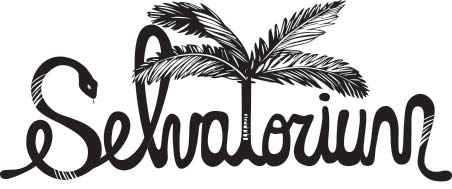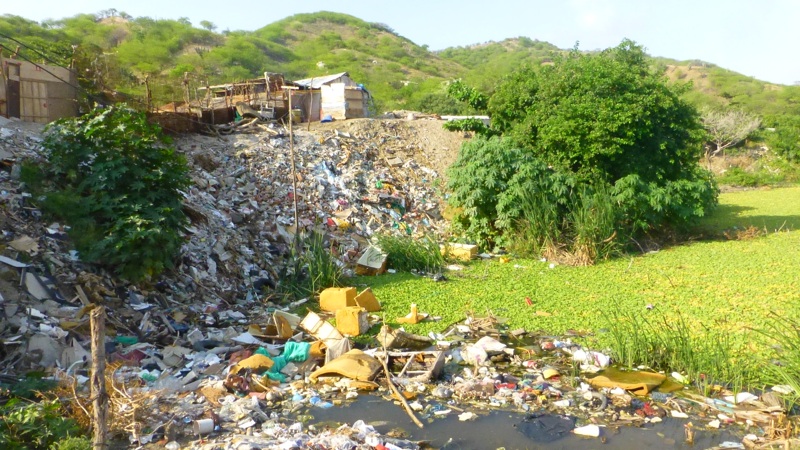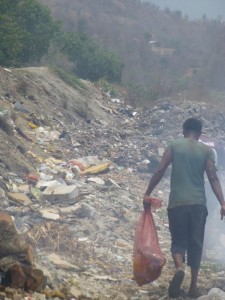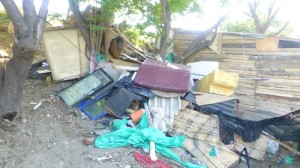Por: Zahra Hdidou
Espanol
(see below in blue for english)
Domingo pasado fuimos al Oasis por la primera vez, Heriberto, Jeffrey y yo. Conocimos Juan, el Hijo de Arcelis una mujer muy activa en el barrio, que nos presento a Chungo, nuestro entrevistado del dia. Chungo crecio en una finca en la Sierra Nevada cerca de Minca, y sirvio en el ejercito por 11 anos antes de mudarse al Oasis para trabajar como ‘reciclador’ o recuperante de basura. Eso consiste de trabajar por unas 6 horas por dia buscando objetos en el basurero al lado del barrio que podrian ser utiles para crear o construir un objeto Nuevo o para vender. El lleva objetos desde el basurero hasta un cobertizo al lado de su casa donde hace sus creaciones nuevas. Otra cosa su trabajo consiste de recoger la basura clasificado al por mayor en una carro mulla o un cubo de basura para vender a las empresas. Chungo nos trajo a un laguito estancada a la entrada del barrio donde comenzamos a grabar la entrevista. Nos dijo como el laguito es un problema ya que atrae moscas y mosquitos que propagan enfermedades. Tambien nos hablo del barrio y el asunto de contaminacion que existe por la basura. Sentio que la accion la mas util que se podria tomar es una limpieza enorme con la participacion de todos los ninos, ademas de un taller sobre como categorizar los diferentes tipos de basura para reciclarlas.
Pues nos llevo por un tour del barrio y vimos como el systema de agua esta muy mal. La tuberia – la fuente principal de agua para consumir – corre encima de la tierra y esta rota, asi que el agua corre por la calle sucia. Aca los ninos usan el agua, pero ya no sabemos cuantos familias usan este agua, inevitablemente contaminada.
Regresamos al Oasis el martes donde conocimos a Arcelis. Arcelis es una mujer indígena del grupo étnico los Kankuamos, que se han perseguido por los últimos 30 anos los guerrilleros, los paramilitarios, y hasta las fuerzas armadas. Los Kankuamos han sufrido desplazamiento forzado, masacres, contratación forzada en grupos armados ilegal y la violencia sexual, cosas que aun continúan con la militarización de las tierras ancestrales. Arcelis misma fue desplazada hace 20 anos y se encuentro en el Oasis. Ella y su hijo Juan sobreviven principalmente por su burra que se alquila a los recicladores como Chungo a cambio de que ellos hagan trabajos para ella. Arcelis también vende mochilas indígenas de su pueblo natal en la Sierra Nevada con el cual aun tiene contacto.
Arcelis había acabado de asistir un curso de la Cruz Roja sobre la manipulación alimentaria, pues ella nos trajo a su casa para la entrevista. Ella nos dijo que un proyecto a llevar en el barrio debería centrarse en las mujeres ya que ellas se cuidan de los niños y se conciernen en la alimentación y la salud. Además tienen mas tiempo que los hombres que están fuera trabajando durante el día y no se preocupen con los niños. Arcelis insistió que se debe mejorar y aumentar las capacidades de los padres para que puedan salir de la pobreza. También siente que la contaminación causada por la basura es un gran problema, y la falta de baños en muchos hogares. Dijo que las verduras que los residentes compran de otra parte están llenas de químicos, entonces creyó que hacer un jardín de verduras para el barrio seria muy útil y aportaría mucho para una dieta sana.
Despues fuimos a buscar el presidente de la Junta de Acción Comunal pero no estaba, entonces hablamos con Juledis que trabaja para la Junta. Le dio gusto escuchar que Intermundos quiere llevar a cabo un proyecto en el barrio el Oasis, y estuvo contenta de organizar un reunión con el Presidente de la Junta cuando regresa sobre los detalles del taller, su factibilidad y los logísticas.
Luego encontramos a Chungo otra vez que nos mostro el basurero al lado del barrio, del otro lado de la línea del ferrocarril, que es su lugar de trabajo. El camina entre los residuos tomando objetos que puede visualizar como parte de un nuevo creación, tal como plástico sólido o una estructura alambre. Nos encontramos con un otro reciclador que es presidente de una cooperativa de recicladores en Santa Marta y Chungo lo ayudo a cargar cartón y plástico en un contenedor de la basura.
La basura que se tira aya viene por todo Santa Marta. Es el resultado de la falta del reciclaje y eliminación apropiada de desechos por la gente en Santa Marta, pero también es una fuente de trabajo para personas como Chungo. Eso es la paradoja.
El domingo asistimos a una reunión de la cooperativa de recicladores al polideportivo en Santa Marta, donde el objetivo fue de organizar mejor la comunidad de recicladores y de gestionar su trabajo para que eviten el conflicto, para que esto tipo de trabaja puede continuar. El conflicto es a menudo entre los recicladores y los barrios en que suelen tirar su basura no deseada, que crea problemas por supuesto en los barrios como el Oasis.
Podríamos concluir que la grand cantidad de basura que hay en el Oasis es a causada de las acciones de los recicladores. Aunque ha sido muy difícil conseguir de los recicladores en el Oasis información fiable sobre de donde viene la basura en el barrio y alrededor del laguito, salvo que ‘viene de todo Santa Marta’. La moderadora de la reunión, Liliana, recalco que era crucial que los recicladores no botan la basura en otros barrios. También presente estaba un señor de una empresa que compran basura separada por los recicladores. La reunión también toco una nueva meta; la de conseguir otras formas de transporte aparte de los burros que son bastante costoso para alimentar y cuidar. Liliana accedió de encontrarnos un otro día para explicar en mas detalle el trabajo de la comunidad de los recicladores y los asuntos que la rodean.
English
On Sunday we went on our first visit to el Oasis, Heriberto, Jeffrey and I. We met Juan, the son of Arcelis a very active woman in the neighbourhood, who took us to meet Chungo, who was to be our main interviewee of the day. Chungo grew up on a finca in the Sierra Nevada near Minca, and served in the army for 11 years before he ended up in el Oasis working as a ‘recycler’ or rubbish collecter. This involves working for around 6 hours a day searching for items in the landfill site beside el Oasis which could be useful to create or build a new object, to then be sold on. He carries objects from the dump to a small shack by his house where he makes his new creations. Otherwise his work involves gathering sorted rubbish in bulk in a donkey cart or a large skip (cubo de basura) to sell on to companies. Chungo took us to a small, stagnant lake at the entrance to the village where we then filmed the interview. He told us how the lake is a problem as it attracts flies and mosquitoes which spread illnesses; also about the neighborhood and the issue that it faces of contamination from rubbish. He felt that the most useful action that could be taken is a huge clear up of the neighborhood involving all the kids, and a workshop on how to categorize different sorts of rubbish in order to recycle them.
We were next taken on a tour of the neighborhood where we saw just how poor the water system is. The water pipe – which is the main source of water for consumption – runs through the neighborhood in the open air and is broken half way, so that the water runs through the wasteful street. Here the children use the water, but we have yet to find out whether this inevitably contaminated water then goes to the whole neighborhood for use.
We returned to el Oasis on Tuesday where we met Arcelis. Arcelis is an indigenous woman from the Kankuamo ethnic group, who have been persecuted over the last 30 years by guerrilla groups, paramilitaries, and even the armed forces. The Kankuamos have suffered forced displacement, massacres, forced recruitment into illegal armed groups and sexual violence, which is still happening in the present day with the militarisation of ancestral lands. Arcelis herself was displaced 20 years ago and found herself in el Oasis. She and her son Juan now survive mostly through her donkey which she hires out for use to recyclers like Chungo, who in return work for her. Arcelis also sells indigenous mochilas from her people in the Sierra Nevada with which she still has contact.
Arcelis had just attended a class by the Red Cross on food sanitation and preparation, then took us to her house for the interview. She asserted her feelings about the importance of the inclusion and focus on women in the project that we want to carry out, since the women take care of the children, are more concerned about diet and health. Moreover they have more time than the men who are out working during the day and don’t occupy themselves with children. Arcelis insisted that the capacity of parents needs to be improved in order to escape poverty. She felt that contamination from rubbish was a big problem, also the lack of toilets in many households. Arcelis told us how the vegetables that the people of el Oasis buy from elsewhere are full of chemicals, and believed that making a small vegetable garden for the neighborhood would be useful in contributing to a healthy diet.
Following this interview we went to search for the President of the Junta de Accion Comunal, but he was away so we met with Juledis who works in the Junta. She was pleased to hear about Intermundos’ plans to carry out a project in the neighborhood, and were glad to organize a meeting with the President on his return concerning the project’s feasibility, details, and logistics.
Once again we met Chungo who took us to the garbage dump site beside the neighborhood on the other side of a railway line, which is his workplace. He walks through the waste picking up objects he can visualize as part of a new creation, such as solid plastic or a wire frame. We met another recycler who is the President of a recyclers cooperative in Santa Marta, and Chungo begins helping him to load cardboard and plastic into a skip. The rubbish dumped here comes from all over Santa Marta. It is the result of the lack of recycling and the proper sorting of waste by people in Santa Marta, but it is also the source of work for people like Chungo. Here is the paradox.
On Sunday we attended a meeting of the recyclers’ cooperative at the sporting grounds in Santa Marta, in which the objective was to organize better the recycling community and to manage the work of the recyclers in order to avoid conflict, so that this type of work can continue. The conflict is often between recyclers and the neighborhoods in which recyclers tend to dump their unwanted rubbish, which obviously causes problems in neighborhoods such as el Oasis. We could come to a conclusion that the extent of rubbish in el Oasis is the due to the actions of recyclers. Although it has been very hard to get solid information from recyclers in el Oasis about where the rubbish in the neighborhood and around the lake comes from, other than ‘it comes from Santa Marta’. The chairwoman of the meeting, Liliana, asserted how vital it is that the recyclers do not dump rubbish in other neighborhoods. Also present was a man from a company which buys sorted rubbish from recyclers. The meeting also raised the current aim of trying to obtain other forms of transport other than donkeys, which are costly to feed and care for. Liliana agreed to meet with us another day to explain in more detail the work of the recycling community and the issues that surround it.








Trackbacks/Pingbacks